-
Original Article
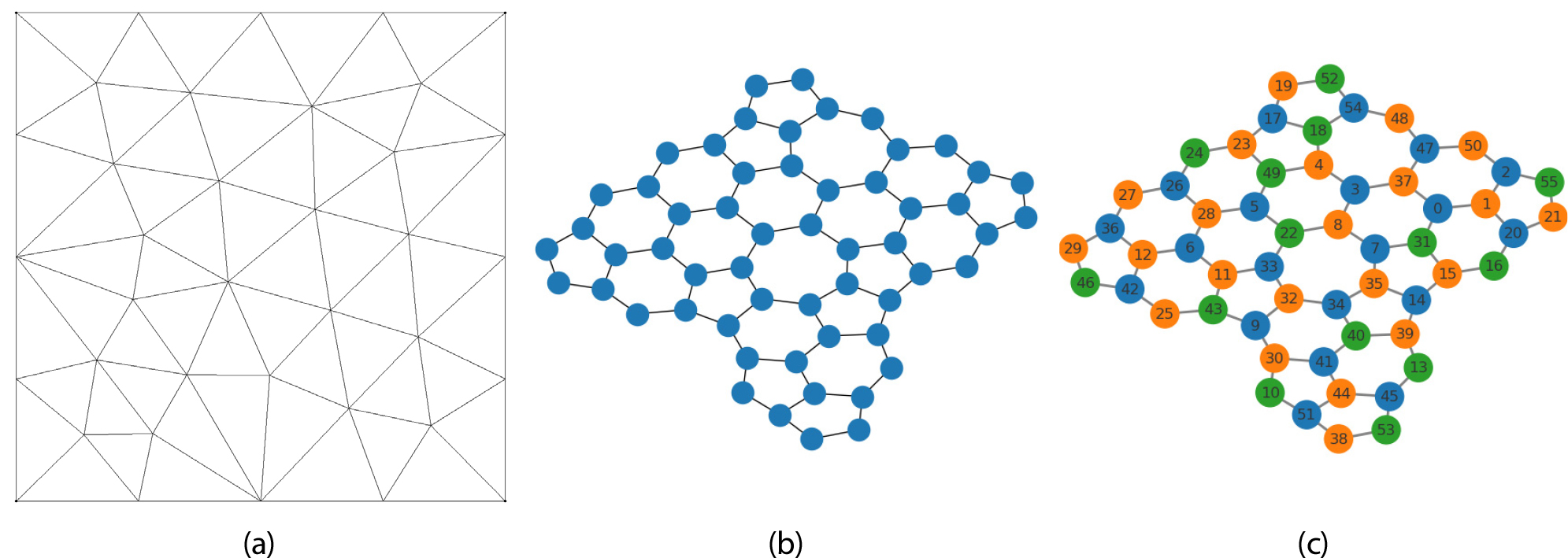
-
PERFORMANCE ANALYSIS OF LU-SGS METHOD USING MULTI-COLORING ALGORITHM AND BLOCK OPERATOR
다중 색상 알고리즘과 행렬 연산자를 적용한 LU-SGS 기법의 성능 분석
-
N. Kim, S. Lee, J.S. Park
김남형, 이승수, 박진석
- In this study, the performance of lower-upper symmetric Gauss-Seidel(LU-SGS) methods with multi-coloring algorithm and block operator were compared on shared memory parallelism. …
- In this study, the performance of lower-upper symmetric Gauss-Seidel(LU-SGS) methods with multi-coloring algorithm and block operator were compared on shared memory parallelism. The LU-SGS scheme is one of the most popular time integration methods in CFD due to its remarkable robustness and convergence performance; however, data dependency has obstructed the application of the shared memory parallelism. To handle this problem, Colored LU-SGS method is introduced, removing data dependency by applying multi-coloring algorithm to unstructured grid. Albeit the multi-coloring algorithm has high concurrency in parallel execution, it may degrade the implicit property of the numerical method and affect convergence efficiency. Colored Block LU-SGS method uses a block operator, which maintains matrix property of the flux Jacobian so that it can improve convergence stability. Numerical experiments were conducted to validate its efficiency and performance compared with the Colored LU-SGS method. The analysis confirmed that the Colored Block LU-SGS method has a greater maximum CFL number and faster convertgence rate with reference to the total iteration number, and computation time. - COLLAPSE
-
PERFORMANCE ANALYSIS OF LU-SGS METHOD USING MULTI-COLORING ALGORITHM AND BLOCK OPERATOR
-
Original Article
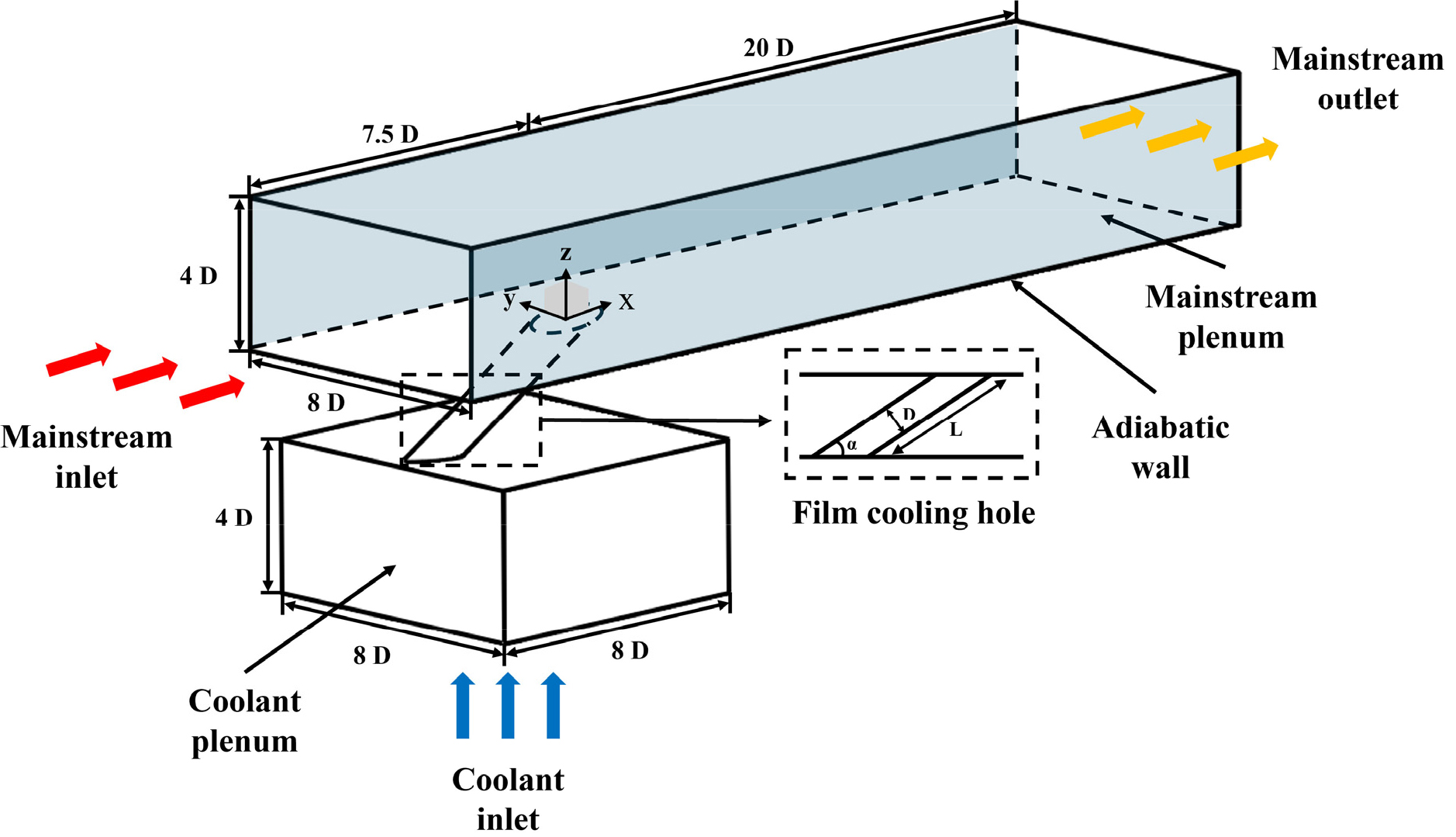
-
THE NUMERICAL INVESTIGATION ON THE EFFECT OF HELICAL FILM HOLE SHAPE VARIATION ON FILM COOLING PERFORMANCE
나선형 냉각 홀 형상 변화가 막 냉각 성능에 미치는 영향에 대한 수치 해석 연구
-
G.H. Kim, H. Park
김건호, 박희성
- A numerical study was conducted to investigate the effects of variations in cooling hole shape on film cooling performance. The injection angle …
- A numerical study was conducted to investigate the effects of variations in cooling hole shape on film cooling performance. The injection angle and shapes of the cooling holes were designed with 30° injection angle, cylindrical shape and swirling hole shape with various pitch configurations. Film cooling effectiveness was compared under blowing ratios of 0.5, 1 and 1.5. The flow sturctures and characteristics were analyzed. The results show that as blowing ratios increases, swirling flow promotes coolant reattachment to the surface and mitigates lift-off tendencies, thereby improving film cooling effectiveness. And swirl strength has a significant influence on film cooling performance. Compared to conventional cylindrical holes, pitch 10 swirling hole shape improves in area-averaged cooling effectiveness by 4.36% and 9.52% at blowing ratios of 1 and 1.5, respectively. - COLLAPSE
-
THE NUMERICAL INVESTIGATION ON THE EFFECT OF HELICAL FILM HOLE SHAPE VARIATION ON FILM COOLING PERFORMANCE
-
Original Article

-
WORKABILITY ANALYSIS BASED ON RECESS DECK HEIGHT INSIDE MOONPOOL WITH A BOW WAVE
선수파에 대한 문풀 내부의 Recess Deck 높이에 따른 작업성 해석
-
S. Ahn, S. Park, S. Yang
안서연, 박선호, 양승호
- It has been reported that when a drill ship is working in a stationary state, turbulent flow occurs inside the moon pool …
- It has been reported that when a drill ship is working in a stationary state, turbulent flow occurs inside the moon pool due to the inflow of ocean waves, which can seriously threaten work delays and worker safety. In this study, a computational fluid dynamics analysis of the internal flow of a drillship moon pool was carried out for various heights of the recess deck. OpenFOAM, which is an open source library, was used for simulations. KCS was selected as the drill ship, and the recess deck heights were designed to be 0.0375 L, 0.0307 L, 0.0238 L, and 0.0169 L, respectively. The head wave was considered and the 5th–order Stokes wave was applied. By observing the change of free-surface flow inside the moon pool in each case, it is confirmed that the recess deck height affects the reduction of flow inside the moon pool. It is expected that the recess deck height derived from the results of this study can contribute to increasing the work efficiency and improving the safety of workers in the moon pool. - COLLAPSE
-
WORKABILITY ANALYSIS BASED ON RECESS DECK HEIGHT INSIDE MOONPOOL WITH A BOW WAVE
-
Original Article
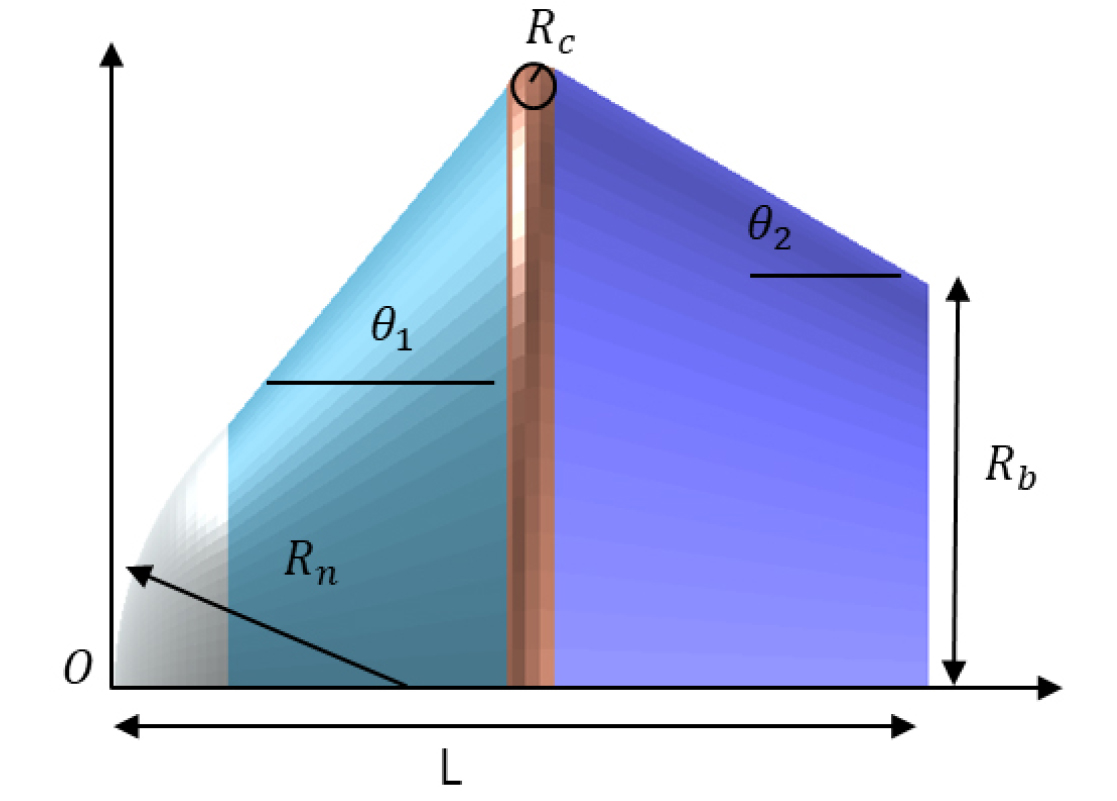
-
MULTI-OBJECTIVE SHAPE OPTIMIZATION OF EARTH RE-ENTRY CAPSULE USING LOW FIDELITY AERO-THERMAL ANALYSIS CODE
저 충실도 극초음속 열-공력 해석코드를 이용한 지구 재진입 캡슐 다목적 형상 최적화
-
M. Lee, K.H. Kim, N. Kim, H. Kim
이민술, 김규홍, 김낙완, 김형진
- This study presents the multi-objective shape optimization of a re-entry capsule using an aero-thermal analysis engineering code. The capsule geometry was defined …
- This study presents the multi-objective shape optimization of a re-entry capsule using an aero-thermal analysis engineering code. The capsule geometry was defined based on the three-dimensional axisymmetric Viking geometry, parameterized by five design variables. An unstructured triangular mesh was automatically generated for the surface geometries. The local surface inclination method and reference temperature method were utilized to calculate surface pressure and skin friction coefficients. Additionally, a streamline tracing method was implemented to compute the local Reynolds number, while the stagnation heat flux was calculated using the Brandis formula and off-stagnation heat flux was calculated using Reynolds analogy. The optimization was performed for flow conditions at Mach 35.37, a 0-degree angle of attack, and an altitude of 61.8 km, using the multi-objective evolutionary algorithm NSGA-III. Pareto optimal solutions were evaluated, and the optimal solutions were selected based on volumetric efficiency, drag area, and total heat energy. The performance of selected Pareto optimal solutions was analyzed with respect to three objective functions, along with total mass and ballistic coefficient. - COLLAPSE
-
MULTI-OBJECTIVE SHAPE OPTIMIZATION OF EARTH RE-ENTRY CAPSULE USING LOW FIDELITY AERO-THERMAL ANALYSIS CODE
-
Original Article
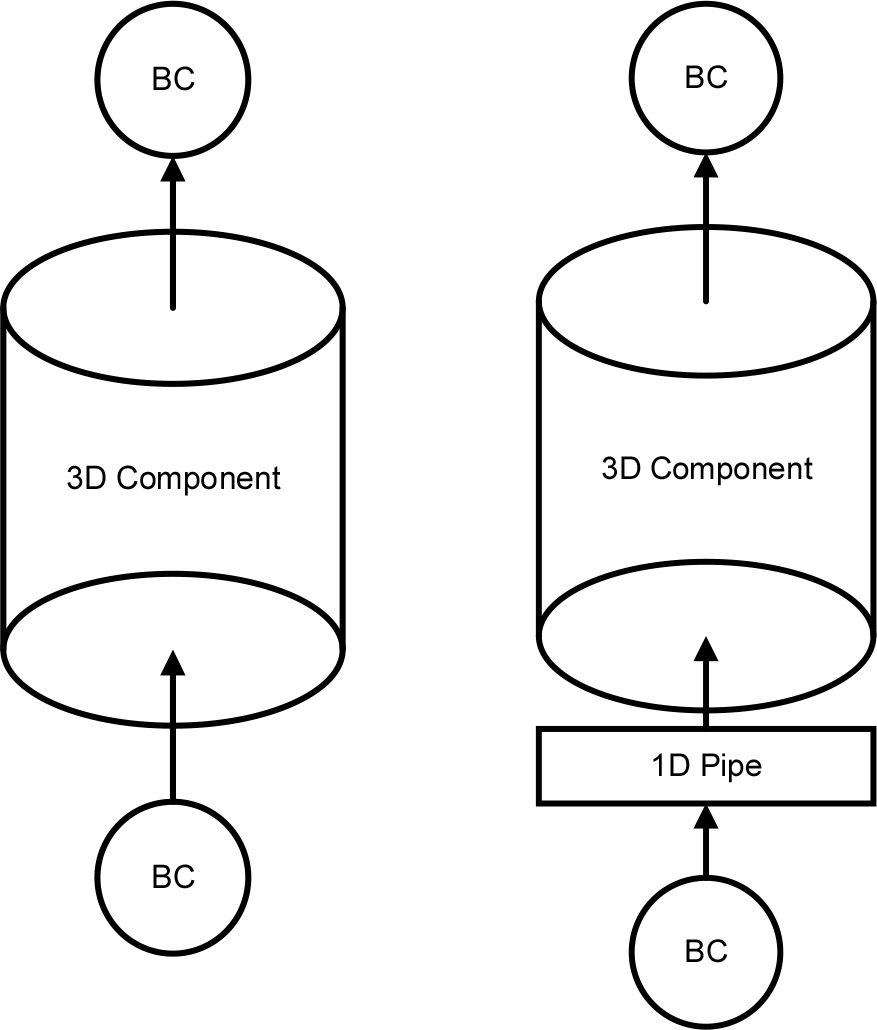
-
DEVELOPMENT OF TURBULENCE MODEL FOR AN INTEGRATED SYSTEM OF 1D PIPES AND MULTIDIMENSIONAL COMPONENTS
일차원 파이프와 다차원 구조체 연계 시스템에 대한 난류모델 개발
-
J. Heo, S.H. Yoon, N.I. Tak
허재석, 윤승현, 탁남일
- In this study, a turbulence model was defined at the interface between one-dimensional(1D) pipes and multidimensional(MD) structures. In the existing GAMMA+ code, …
- In this study, a turbulence model was defined at the interface between one-dimensional(1D) pipes and multidimensional(MD) structures. In the existing GAMMA+ code, turbulent flow at the junction between 1D and MD regions is calculated by directly applying the turbulent kinetic energy and dissipation rate from the edge cells of the MD structure, which can result in non-physical turbulence predictions. To address this issue, a turbulence model was developed for the 1D-MD interface, based on the turbulent kinetic energy and dissipation rate approach implemented in ANSYS FLUENT. Validation calculations were performed on an integrated system of a 1D pipe and a 3D component. The results indicate that predictions obtained with the proposed turbulence model are more consistent with the target solutions, suggesting improved physical accuracy over the existing turbulence model. - COLLAPSE
-
DEVELOPMENT OF TURBULENCE MODEL FOR AN INTEGRATED SYSTEM OF 1D PIPES AND MULTIDIMENSIONAL COMPONENTS
-
Original Article
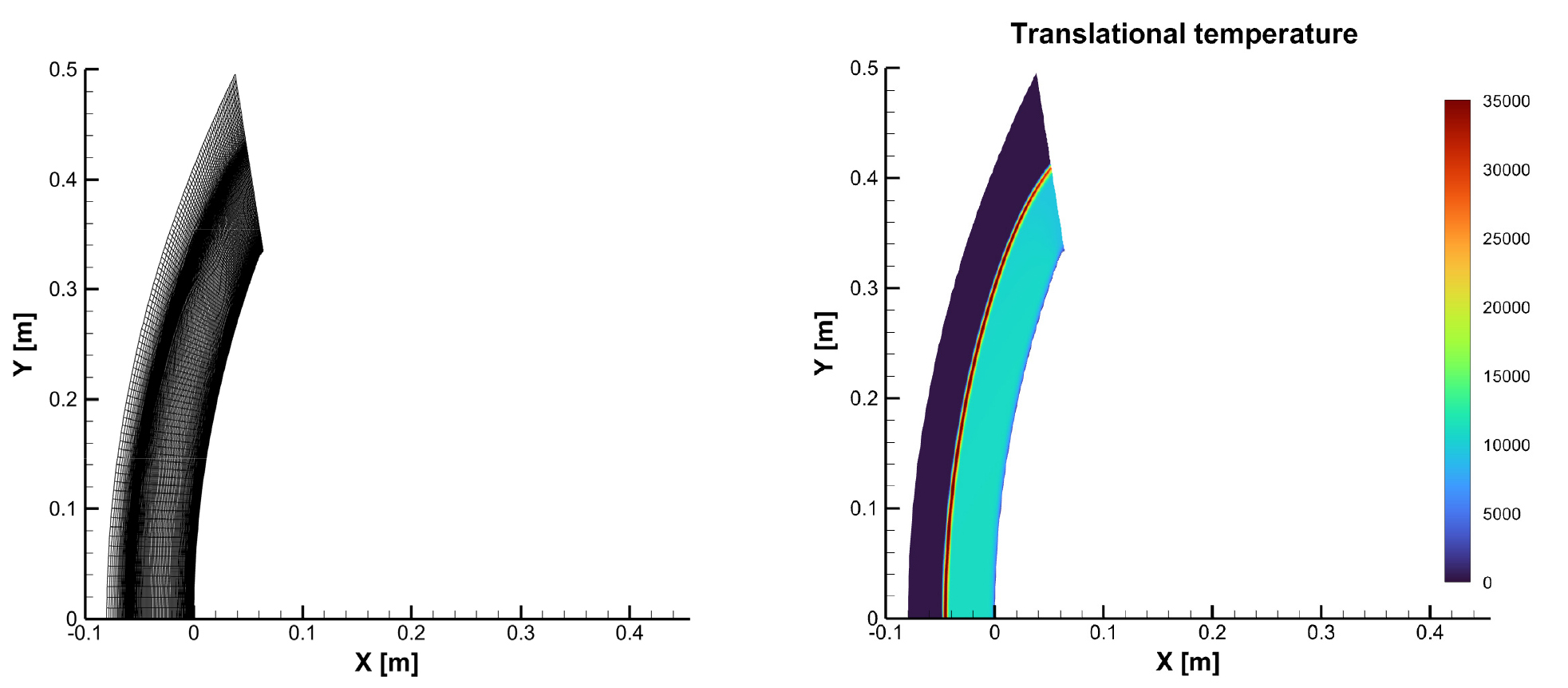
-
EFFECTS OF THE WALL ELECTRON TEMPERATURE BOUNDARY CONDITION UNDER EARTH REENTRY FLIGHT REGIME
지구 재진입 비행 영역에서 벽 전자 온도 경계 조건의 영향
-
C. Kim, H. You, J.G. Kim, N. Kim, K.H. Kim
김찬호, 유호준, 김재강, 김낙완, 김규홍
- The effects of the wall electron temperature boundary condition on the boundary layer temperature and surface heat flux are analyzed in the …
- The effects of the wall electron temperature boundary condition on the boundary layer temperature and surface heat flux are analyzed in the Earth reentry environment. Due to the distinct characteristics of free electrons, which set them apart from heavy particles, it remains questionable to assume that the wall electron temperature is identical to that of heavy particles. The thermochemical nonequilibrium four temperature model, which takes into account the translational, rotational, vibrational, and electron-electronic energies of chemical species, is used in hypersonic computational fluid dynamics. Computational results are compared by applying Dirichlet and Neumann boundary conditions under the FIRE-II and Hayabusa flight conditions. The presented modified Neumann boundary condition demonstrates enhanced numerical stability and convergence compared to the Dirichlet boundary condition under Earth reentry conditions. The electron energy contribution to the surface heat flux decreases with the Neumann boundary condition, but its effect on the total heat flux is negligible. Wall electron temperature indicates the electron energy state and is essential for the development of thermal protection systems that require precise free electron distribution and energy state prediction. The findings of this study are expected to contribute to more numerically and physically accurate predictions of the electron energy temperature distribution in Earth reentry vehicles. - COLLAPSE
-
EFFECTS OF THE WALL ELECTRON TEMPERATURE BOUNDARY CONDITION UNDER EARTH REENTRY FLIGHT REGIME
-
Original Article

-
PREDICTION OF PASSENGER EAR DISCOMFORT IN TUNNEL-RUNNING HIGH-SPEED TRAIN USING ARTIFICIAL NEURAL NETWORKS
인공신경망을 활용한 터널 주행 고속철도차량의 승객 이명감 예측
-
H.M. Kang, H.B. Kwon
강형민, 권혁빈
- An artificial neural network-based response surface was developed to predict passenger ear discomfort in high-speed trains traveling through tunnels. For this, axisymmetric …
- An artificial neural network-based response surface was developed to predict passenger ear discomfort in high-speed trains traveling through tunnels. For this, axisymmetric flow analysis was conducted on high-speed trains running through tunnels, with variations in tunnel cross-sectional area, tunnel length, and train speed. Then, the time-dependent pressure change rate, derived from the pressure changes inside the train’s cabin, was obtained as the results of CFD computations. Subsequently, the response surface based on the artificial neural network was constructed from the results. The prediction errors between the response surface results and the actual CFD analysis values were within 2%. This confirmed the reliability and efficiency of the proposed passenger discomfort prediction method of the artificial neural network-based response surface. - COLLAPSE
-
PREDICTION OF PASSENGER EAR DISCOMFORT IN TUNNEL-RUNNING HIGH-SPEED TRAIN USING ARTIFICIAL NEURAL NETWORKS
-
Original Article
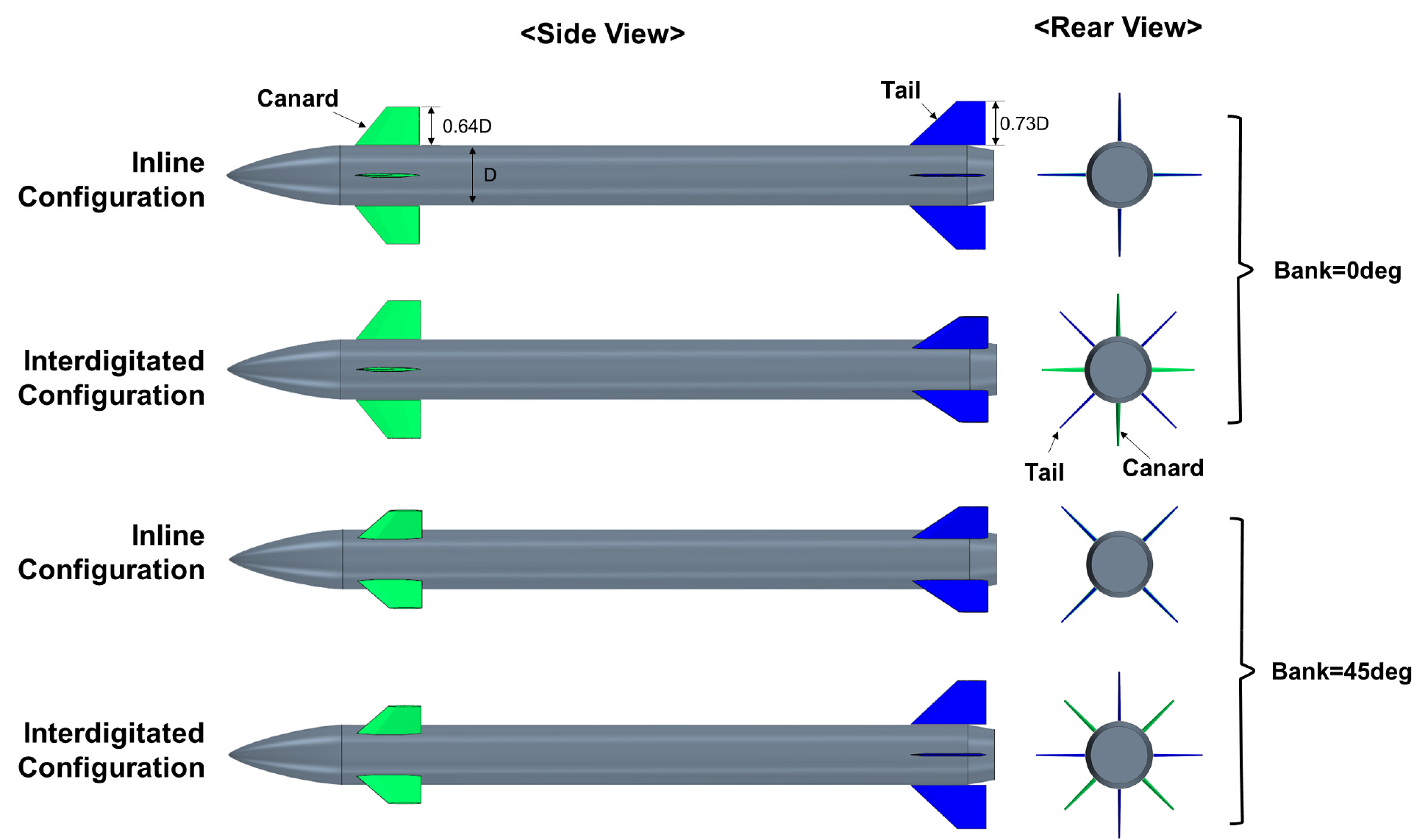
-
ANALYSIS OF AERODYNAMIC CHARACTERISTICS FOR CANARD CONTROLLED MISSILE WITH FREE-ROTATING TAIL
자유 회전 꼬리날개가 적용된 카나드 제어 유도탄의 공력 특성 분석
-
Y. Kim, K.T. Kang
김영화, 강경태
- Free-rotating tail fins have been widely employed in canard controlled guided missiles to mitigate unintended canard-induced moments reducing control effort. However, aerodynamic …
- Free-rotating tail fins have been widely employed in canard controlled guided missiles to mitigate unintended canard-induced moments reducing control effort. However, aerodynamic characteristics of free-rotating tail remain not fully understood due to complex interaction with the missile body and canard control surfaces. This study investigates the fundamental aerodynamic characteristics of free-rotating tail through wind tunnel experiments and CFD analysis of a canard controlled missile with fixed tail and free-rotating tail. CFD simulations are conducted at Mach numbers 1.2, 1.6 and 3.0 using RANS models for fixed tail(x-tail and +-tail) and URANS with a sliding mesh approach for free-rotating tail. The aerodynamic coefficients of CFD results show good agreement with those of wind tunnel measurements. Based on the results, the fundamental aerodynamic characteristics of missiles with free-rotating tail are characterized, and an efficient aerodynamic evaluation approach is discussed. - COLLAPSE
-
ANALYSIS OF AERODYNAMIC CHARACTERISTICS FOR CANARD CONTROLLED MISSILE WITH FREE-ROTATING TAIL
-
Original Article

-
COMPUTATIONAL ANALYSIS OF ICE ACCRETION ON DIRCM INSTALLED ON A MEDIUM-SIZED TRANSPORT AIRCRAFT
중형 수송기에 장착된 DIRCM의 결빙 증식에 관한 전산 해석
-
J.H. Park, Y.I. Kim, B.H. Lee, J.H. Lee, G. An, G. Kim, H. Lee, R.S. Myong
박재현, 김영일, 이병헌, 이주한, 안건, 김건, 이학진, 명노신
- The icing of medium-sized transport aircraft can occur when supercooled water droplets impinge on the aircraft surface during flight. In particular, icing …
- The icing of medium-sized transport aircraft can occur when supercooled water droplets impinge on the aircraft surface during flight. In particular, icing of air and optical sensors can degrade performance, thereby reducing mission success rates and compromising safety. In this study, a computational analysis of ice accretion on a DIRCM (directional infrared counter measures) installed on a medium-sized transport aircraft, a task that has rarely been studied before, was performed under Part 25 Appendix C. The results showed that ice accretion occurred on the rear surface of the optical window under glaze ice conditions, particularly when small droplets were encountered. Furthermore, when a structure was installed in front of the optical window, ice accretion was significantly reduced. However, due to instability caused by vortices and limitations in DIRCM operation, additional structure installation was deemed impractical. In the future, this study can provide baseline data for optimizing the anti-icing design of aircraft survivability equipment. - COLLAPSE
-
COMPUTATIONAL ANALYSIS OF ICE ACCRETION ON DIRCM INSTALLED ON A MEDIUM-SIZED TRANSPORT AIRCRAFT
Journal Informaiton
 Journal of Computational Fluids Engineering
Journal of Computational Fluids Engineering
Journal Informaiton
Journal Informaiton - close
 Journal of Computational Fluids Engineering
Journal of Computational Fluids Engineering












